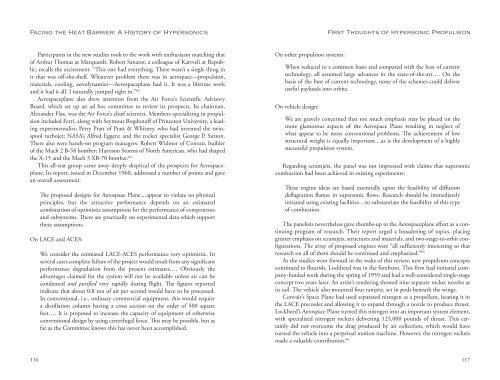Facing the Heat Barrier - NASA's History Office
Facing the Heat Barrier - NASA's History Office
Facing the Heat Barrier - NASA's History Office
You also want an ePaper? Increase the reach of your titles
YUMPU automatically turns print PDFs into web optimized ePapers that Google loves.
<strong>Facing</strong> <strong>the</strong> <strong>Heat</strong> <strong>Barrier</strong>: A <strong>History</strong> of Hypersonics<br />
Participants in <strong>the</strong> new studies took to <strong>the</strong> work with enthusiasm matching that<br />
of Arthur Thomas at Marquardt. Robert Sanator, a colleague of Kartveli at Republic,<br />
recalls <strong>the</strong> excitement: “This one had everything. There wasn’t a single thing in<br />
it that was off-<strong>the</strong>-shelf. Whatever problem <strong>the</strong>re was in aerospace—propulsion,<br />
materials, cooling, aerodynamics—Aerospaceplane had it. It was a lifetime work<br />
and it had it all. I naturally jumped right in.” 63<br />
Aerospaceplane also drew attention from <strong>the</strong> Air Force’s Scientific Advisory<br />
Board, which set up an ad hoc committee to review its prospects. Its chairman,<br />
Alexander Flax, was <strong>the</strong> Air Force’s chief scientist. Members specializing in propulsion<br />
included Ferri, along with Seymour Bogdonoff of Princeton University, a leading<br />
experimentalist; Perry Pratt of Pratt & Whitney, who had invented <strong>the</strong> twinspool<br />
turbojet; NASA’s Alfred Eggers; and <strong>the</strong> rocket specialist George P. Sutton.<br />
There also were hands-on program managers: Robert Widmer of Convair, builder<br />
of <strong>the</strong> Mach 2 B-58 bomber; Harrison Storms of North American, who had shaped<br />
<strong>the</strong> X-15 and <strong>the</strong> Mach 3 XB-70 bomber. 64<br />
This all-star group came away deeply skeptical of <strong>the</strong> prospects for Aerospaceplane.<br />
Its report, issued in December 1960, addressed a number of points and gave<br />
an overall assessment:<br />
116<br />
The proposed designs for Aerospace Plane…appear to violate no physical<br />
principles, but <strong>the</strong> attractive performance depends on an estimated<br />
combination of optimistic assumptions for <strong>the</strong> performance of components<br />
and subsystems. There are practically no experimental data which support<br />
<strong>the</strong>se assumptions.<br />
On LACE and ACES:<br />
We consider <strong>the</strong> estimated LACE-ACES performance very optimistic. In<br />
several cases complete failure of <strong>the</strong> project would result from any significant<br />
performance degradation from <strong>the</strong> present estimates…. Obviously <strong>the</strong><br />
advantages claimed for <strong>the</strong> system will not be available unless air can be<br />
condensed and purified very rapidly during flight. The figures reported<br />
indicate that about 0.8 ton of air per second would have to be processed.<br />
In conventional, i.e., ordinary commercial equipment, this would require<br />
a distillation column having a cross section on <strong>the</strong> order of 500 square<br />
feet…. It is proposed to increase <strong>the</strong> capacity of equipment of o<strong>the</strong>rwise<br />
conventional design by using centrifugal force. This may be possible, but as<br />
far as <strong>the</strong> Committee knows this has never been accomplished.<br />
On o<strong>the</strong>r propulsion systems:<br />
First Thoughts of Hypersonic Propulsion<br />
When reduced to a common basis and compared with <strong>the</strong> best of current<br />
technology, all assumed large advances in <strong>the</strong> state-of-<strong>the</strong>-art…. On <strong>the</strong><br />
basis of <strong>the</strong> best of current technology, none of <strong>the</strong> schemes could deliver<br />
useful payloads into orbits.<br />
On vehicle design:<br />
We are gravely concerned that too much emphasis may be placed on <strong>the</strong><br />
more glamorous aspects of <strong>the</strong> Aerospace Plane resulting in neglect of<br />
what appear to be more conventional problems. The achievement of low<br />
structural weight is equally important…as is <strong>the</strong> development of a highly<br />
successful propulsion system.<br />
Regarding scramjets, <strong>the</strong> panel was not impressed with claims that supersonic<br />
combustion had been achieved in existing experiments:<br />
These engine ideas are based essentially upon <strong>the</strong> feasibility of diffusion<br />
deflagration flames in supersonic flows. Research should be immediately<br />
initiated using existing facilities…to substantiate <strong>the</strong> feasibility of this type<br />
of combustion.<br />
The panelists never<strong>the</strong>less gave thumbs-up to <strong>the</strong> Aerospaceplane effort as a continuing<br />
program of research. Their report urged a broadening of topics, placing<br />
greater emphasis on scramjets, structures and materials, and two-stage-to-orbit configurations.<br />
The array of proposed engines were “all sufficiently interesting so that<br />
research on all of <strong>the</strong>m should be continued and emphasized.” 65<br />
As <strong>the</strong> studies went forward in <strong>the</strong> wake of this review, new propulsion concepts<br />
continued to flourish. Lockheed was in <strong>the</strong> forefront. This firm had initiated company-funded<br />
work during <strong>the</strong> spring of 1959 and had a well-considered single-stage<br />
concept two years later. An artist’s rendering showed nine separate rocket nozzles at<br />
its tail. The vehicle also mounted four ramjets, set in pods beneath <strong>the</strong> wings.<br />
Convair’s Space Plane had used separated nitrogen as a propellant, heating it in<br />
<strong>the</strong> LACE precooler and allowing it to expand through a nozzle to produce thrust.<br />
Lockheed’s Aerospace Plane turned this nitrogen into an important system element,<br />
with specialized nitrogen rockets delivering 125,000 pounds of thrust. This certainly<br />
did not overcome <strong>the</strong> drag produced by air collection, which would have<br />
turned <strong>the</strong> vehicle into a perpetual motion machine. However, <strong>the</strong> nitrogen rockets<br />
made a valuable contribution. 66<br />
117
















